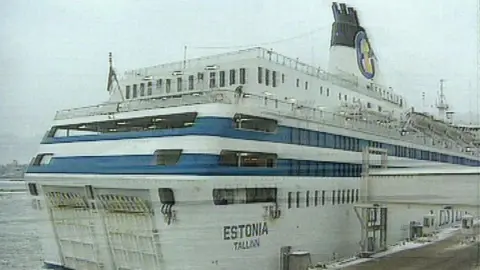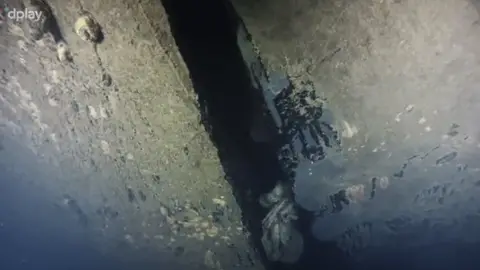Estonia ferry disaster: TV crew uncovers new evidence
 BBC
BBCEstonia, Sweden and Finland will examine new evidence that may shed light on the cause of one of Europe's worst peacetime shipping disasters.
The MS Estonia ferry sank as it was crossing from Tallinn to Stockholm in September 1994, killing 852 people.
A 1997 investigation found that the ship's bow door locks had failed in a storm.
But new underwater footage appears to show a previously unrecorded four metre (13ft) hole in the ship's hull.
The three countries said they would "assess new information" which could contradict the official explanation.
The vessel was sailing from Estonia to Sweden on 28 September 1994 when it sank in the Baltic Sea off Finland. Most passengers on board the ship were trapped inside after it capsized, but 97, who managed to leave the vessel, died in the water. There were 137 survivors.
In 1997, an official report into the incident concluded that the locks on the ship's bow doors had failed during stormy weather and huge amounts of water had gushed in.
But survivors and relatives of the victims have long been calling for a fuller investigation, and various unproven theories have circulated since the tragedy.
The new underwater footage features in a five-part Discovery Network documentary about the disaster titled Estonia: The Find That Changes Everything.
The film crew discovered the hole in the ship's hull while using a remote-controlled submarine to explore the wreckage.
 EPA
EPA"Estonia, Finland and Sweden have agreed that verification of the new information presented in the documentary will be made," the three countries said in a joint statement.
"Our countries will cooperate closely in this matter and Estonia [where the ship was registered] will lead this process," they added.
The new documentary has reignited calls for a fresh investigation. "A new technical investigation into the circumstances of Estonia's sinking must be carried out," Estonia's Prime Minister Juri Ratas said, according to local media.
"A hole in the hull was dismissed over the years," Kent Harstedt, a survivor and former member of the Swedish parliament, told a news conference on Monday. "What has emerged today adds to the question marks - why was the hole not included in the official investigation?"
"I believe the truth is something other than what people have been told until now," survivor Carl Eric Reintamm said in the documentary.
Last year, more than 1,000 survivors and relatives of victims requested €40.8m (£36.6m; $45.8m) in compensation from the French agency that deemed the vessel seaworthy and the German shipbuilder.
But the claim was rejected by a Paris court, which said the claimants had failed to prove "intentional fault".
People from 17 countries lost their lives in the disaster. Of the 852 people killed, 501 were Swedish and 285 were Estonian.
A crew member who survived the accident told the BBC at the time that he had seen a loading bay door open and taking in water minutes before the ship sank.
The Estonia disaster is the second-deadliest peacetime sinking of a European ship after the Titanic.
